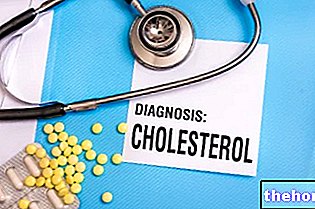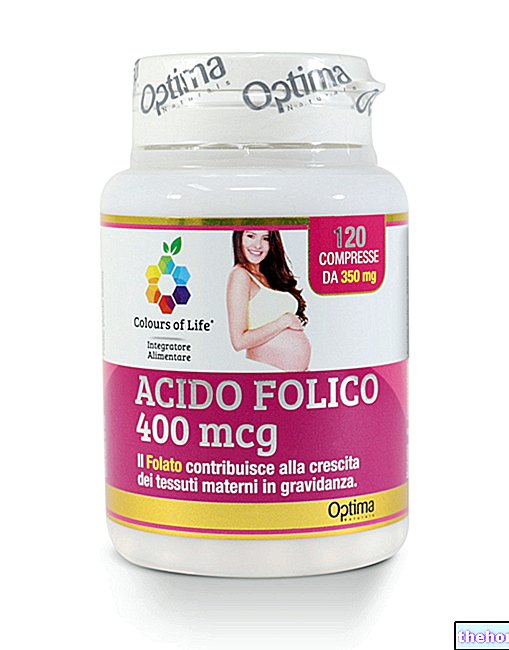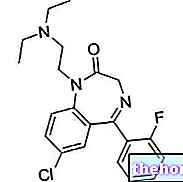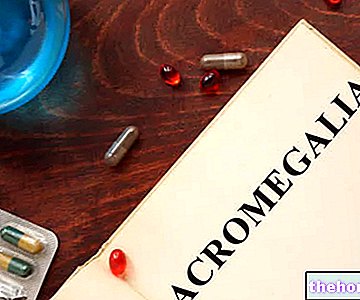Definition
"Hypercalcemia" is defined as a clinical condition in which the level of calcium in the blood exceeds the normal concentration (compared to a reference population); for example, in adults, it is possible to speak of hypercalcemia when plasma calcium exceeds the value of 10.5 mg / dl. The concentration of calcium in the blood is heavily influenced by the activity of calcitonin, parathyroid hormone and vitamin D.
Causes
Hypercalcemia is the result of excessive intestinal absorption of calcium, decreased renal excretion or uncontrolled release of calcium from the bones.
- Risk factors: excessive intake of diuretics, vitamin D, vitamin A and thyroid hormones, high-protein diet, infections, inflammation, hyperparathyroidism, hyperthyroidism, sarcoidosis, tuberculosis, breast and lung cancer
Symptoms
Role of calcium in the body: maintenance of healthy bones, muscle contraction, release of hormones, maintenance of brain and nerve functions
Since calcium is involved in numerous and important functions in the body, an abnormal and exaggerated concentration of plasma calcium can create variable symptoms: hypercalcemia can induce apathy, mental confusion, muscle weakness, depression, dehydration, abdominal pain, bone pain, loss of appetite, gastric hyperacidity, frequent urination, nausea, constipation.
- Complications: severe arrhythmias, coma, renal failure
The information on Hypercalcemia - Medicines for the Treatment of Hypercalcemia is not intended to replace the direct relationship between health professional and patient. Always consult your doctor and / or specialist before taking Hypercalcemia - Medicines for the Treatment of Hypercalcemia.
Medicines
Hypercalcemia is not a medical condition to be underestimated: in fact, when the plasma concentration of calcium exceeds a certain value, hospitalization and emergency treatment are indispensable, even before the cause is clarified.
A hypertensive patient taking thiazide diuretics may be at risk for hypercalcemia; the same is true for those who undergo a "supplementation of vitamin D beyond what is necessary: in these cases, it is necessary to reduce the intake of calcium with the diet, but also to suspend the supplementation of vitamin D and replace a thiazide diuretic with another drug .
Acute hypercalcemia should be treated with an intravenous infusion of sodium chloride (0.9%), to correct dehydration; in cases of severity, the administration of drugs useful for inhibiting bone mobilization, such as bisphosphonates and pamidronic acid, is conceivable: these drugs exert their therapeutic activity by inhibiting bone resorption, consequently increasing the elimination of the mineral through urination. Calcitonin is one of the most used drugs in therapy to bring the calcium concentration to normal, altered by hypercalcemia (especially in the context of malignant diseases).
Furthermore, corticosteroids can excellently exert their therapeutic function when hypercalcemia is associated with excessive intake of vitamin D or sarcoidosis.
Among the less used alternative treatments, we remember chelating drugs (e.g. trisodium edetate): we are talking about an older generation therapy, currently less used than in the past due to its conspicuous side effects (kidney damage) and the local pain caused. at the injection site.
In some severe cases, when hypercalcemia derives from hyperparathyroidism, parathyroidectomy is conceivable, as well as the removal of one or more parathyroid glands.
The following are the classes of drugs most used in the therapy against hypercalcemia, and some examples of pharmacological specialties; it is up to the doctor to choose the most suitable active ingredient and dosage for the patient, based on the severity of the disease, the state of health of the patient and his response to treatment:
Glucocorticoids: indicated to counteract the effects derived from the accumulation of vitamin D in the blood. The administration of these drugs is also indicated for patients suffering from hypercalcemia in the context of sarcoidosis.
- Prednisolone (ex. Deltacortene, Lodotra): the indicative dose for the treatment of hypercalcemia suggests taking 30-60 mg of the drug per day, divided into three daily doses.
Bisphosphonates: these drugs, to be taken intravenously, are indicated in the treatment of hypercalcemia, to remedy the destruction of the bone which, inevitably, would increase the release of calcium into the blood. In other words, bisphosphonates inhibit bone resorption by osteoclasts. Together with the combination furosemide + physiological solution, bisphosphonates are the first-line drugs used in the treatment of hypercalcemia. Below, the most used in therapy.
- Pamidronate (eg. Disodium pamidronate mayne, Aredia): the indicative dose for the treatment of hypercalcemia suggests taking 60-90 mg of the drug, in a single dose, by slow intravenous infusion of 2-24 hours. The long duration of infusion. (longer than 2 hours) is widely used to minimize the risk of renal toxicity. In the case of severe hypercalcaemia, it is recommended to administer a second dose, following the therapeutic scheme used for the first infusion: it should be emphasized, however, that at least 7 days must pass between one dose and the other.
- Zolendronate (eg Zometa): available in powder and solvent, and concentrated to be diluted, the drug carries out its therapeutic activity like the previous one. The dosage should be established by the doctor.
- Ibandronic acid (eg. Bondronat, Bonviva, Ibandronic acid teva, Iasibon, Ibandronic acid sandoz): in the form of a solution for injection, the drug is widely used in therapy for the treatment of hypercalcemia associated with malignant tumor. Administer the drug by IV infusion of 2-4 mg, depending on the severity of the hypercalcemia. Typically, the duration of therapy is 7 days.
- Sodium etidronate (eg etidron): more than for hypercalcemia, the drug under examination is used for the treatment of bone resorption in Paget's disease. In case of tumor-associated hypercalcemia, its use has been severely limited due to renal toxicity of the drug.
The intake of bisphosphonate drugs for the treatment of hypercalcemia can induce: leukopenia, hypophosphatemia and hypocalcemia
Loop diuretic drugs: promote the reduction of calcium levels in the blood, ensuring proper functioning of the kidneys
- Furosemide (eg Lasix): often the administration of furosemide for the treatment of hypercalcemia is associated with an infusion of physiological solution. In patients whose renal function is normal - or in any case not severely compromised - it is conceivable to control plasma calcium levels by increasing renal elimination through expansion of the extracellular volume. The infusion of lasix + physiological solution allows to obtain a urine volume equal to 3 liters per day. It is recommended, in such situations, to monitor the level of potassium in the blood to avoid hypokalaemia: to overcome this problem, it is recommended to inject a physiological solution containing KCl.
Calcitonin: it is a hormone produced by the thyroid, to be taken also to reduce bone absorption and progressive bone loss.
- Calcitonin (eg. Calcitonin Sandoz, 50-100UI, injectable preparation): the drug reduces calcium in the blood by inhibiting the activity of osteoclasts: in this way, the rate of calcium release from the bone is slowed down. We recommend to take a dose of drug by subcutaneous / intramuscular route equal to 4-8 IU / kg, every 12 hours It is advisable to associate prednisone with calcitonin therapy, to obtain greater benefit in a short time.
Chelating drugs: to be used with caution for the treatment of severe hypercalcaemia. The drug is administered by injection: the drug can cause pain at the injection site, as well as kidney damage.
- Edetate disodium (edta): indicated both for acute calcium intoxication and for the treatment of severe hypercalcemia. Consult your doctor. The drug is not used as a first line for the regulation of plasma calcium levels.
Other drugs used for restoring plasma calcium concentration:
- Gallium nitrate (eg Ganite, not on the market in Italy): inhibitor of bone resorption, it is indicated for the treatment of hypercalcemia associated with malignant diseases (bone metastases, parathyroid carcinoma). Second choice drug for the treatment of hypercalcemia, to be taken in case of failure of therapy with loop diuretics and physiological solution. Do not take in case of acute renal failure. The duration of therapy to restore plasma calcium levels is approximately 2 weeks. In patients with mild hypercalcaemia, the recommended dosage is, approximately, less than 100mg / m2 / day, for 5 consecutive days. The daily dose can be administered by slow intravenous infusion (over a 24 hour period).
- Chloroquine phosphate (eg. Chloroquine, Cloroc Fos FN): the active ingredient is indicated to reduce plasma calcium levels in patients suffering from hypercalcemia due to sarcoidosis. It is recommended to take a drug dose of 500 mg per day. The drug can cause damage to the retina.
- Mithramycin or plicamycin (eg. Mithracin): the administration of this drug is reserved for patients suffering from humoral hypercalcemia from malignant metastases: it is observed that, following the administration of the drug, the concentration of calcium in the blood is reduced in 12-36 hours , taking a dose of the drug peri at 25 mcg (0.025 mg) / kg of body weight, for a period of 3-4 days. Consult your doctor.
When hypercalcemia does not benefit from therapy with the drugs described above, it is possible to subject the patient to dialysis or hemodialysis, which are useful for removing excess waste substances and calcium accumulated in the blood; in this way, it is possible to re-establish the correct calcium level.
Cancer-induced hypercalcemia takes second place: the patient will undergo a chemotherapy / radiotherapy treatment or surgery aimed at treating the tumor; the removal of diseased cells will also favor healing from hypercalcemia.




























